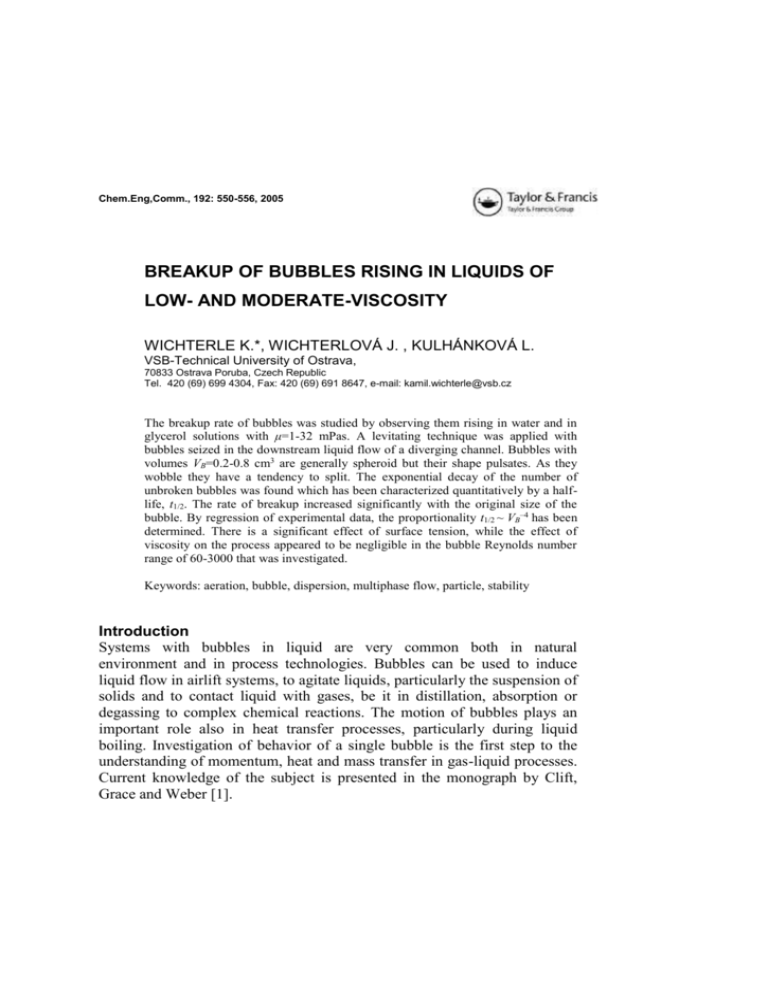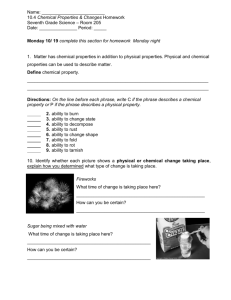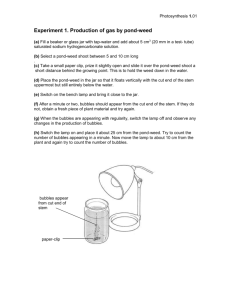breakup of bubbles rising in liquids of low- and moderate
advertisement

Chem.Eng,Comm., 192: 550-556, 2005 BREAKUP OF BUBBLES RISING IN LIQUIDS OF LOW- AND MODERATE-VISCOSITY WICHTERLE K.*, WICHTERLOVÁ J. , KULHÁNKOVÁ L. VSB-Technical University of Ostrava, 70833 Ostrava Poruba, Czech Republic Tel. 420 (69) 699 4304, Fax: 420 (69) 691 8647, e-mail: kamil.wichterle@vsb.cz The breakup rate of bubbles was studied by observing them rising in water and in glycerol solutions with μ=1-32 mPas. A levitating technique was applied with bubbles seized in the downstream liquid flow of a diverging channel. Bubbles with volumes VB=0.2-0.8 cm3 are generally spheroid but their shape pulsates. As they wobble they have a tendency to split. The exponential decay of the number of unbroken bubbles was found which has been characterized quantitatively by a halflife, t1/2. The rate of breakup increased significantly with the original size of the bubble. By regression of experimental data, the proportionality t1/2 ~ VB–4 has been determined. There is a significant effect of surface tension, while the effect of viscosity on the process appeared to be negligible in the bubble Reynolds number range of 60-3000 that was investigated. Keywords: aeration, bubble, dispersion, multiphase flow, particle, stability Introduction Systems with bubbles in liquid are very common both in natural environment and in process technologies. Bubbles can be used to induce liquid flow in airlift systems, to agitate liquids, particularly the suspension of solids and to contact liquid with gases, be it in distillation, absorption or degassing to complex chemical reactions. The motion of bubbles plays an important role also in heat transfer processes, particularly during liquid boiling. Investigation of behavior of a single bubble is the first step to the understanding of momentum, heat and mass transfer in gas-liquid processes. Current knowledge of the subject is presented in the monograph by Clift, Grace and Weber [1]. 551 BREAKUP OF BUBBLES RISING IN LIQUIDS OF LOW- AND MODERATE-VISCOSITY Essentially, the bubble shape is determined by the ratio of gravity forces deforming the bubble and the surface forces keeping its shape in a spherical form. It is expressed for arbitrary liquid systems by the Eötvös number d2 g (1) Eo B with equivalent diameter 6V dB 3 B (2) The influence of viscosity on the shape of a bubble is characterized by the Morton number 4 g M 3 . (3) For low viscosity liquids with M <<10-3, there is no apparent viscosity effect and a single value Eo controls the bubble shape. Small bubbles having Eo<<1 are essentially spherical. Numerous experimental and theoretical studies, including several monographs dealing with bubbles, appeared during last two decades [2-8]. Unfortunately, these studies mostly pay attention to spherical bubbles in viscous liquids and to small perturbations of this case. However, larger bubbles rising at higher Reynolds numbers occur more frequently, both in the nature as well as in industrial processes. Spheroid bubbles are typical for the range of 1<Eo<40. They are kept stable by hydrodynamic forces rather than by the surface tension. With increasing Eo, they slowly lose their fore-and-aft symmetry and, at Eo>40, they acquire a hemispherical or a spherical cap shape. Both the shape the motion of larger bubbles are somewhat unstable, the bubbles wobble during their rise. Such behavior is too complex to be studied theoretically. From an experimental point of view, spheroid bubbles occur within the volume range of 0.01 cm3 <VB<2 cm3 in water and their rising velocity is within the range of 0.15-0.30 m/s. It appears that experimental investigation of such bubbles is usually limited to the recording of their shape and velocity at a single instant. A moving camera or a set of stationary cameras focused to selected points of the column [9] may solve some problems. However, in the measuring section of even large columns [10] (having the inside diameter up to 0.6 m and the height of 4 m) bubbles spent only 10-20 s and a particular bubble can be observed for only a very short period. This is insufficient to investigation of such processes as breakup and coalescence. One possible solution is to observe bubbles in the downstream flow of liquid in transparent channel [11]. Time to time, large bubbles release smaller, daughter bubbles. A class of medium size spheroid bubbles resulting from this breakup is 55 552 K.WICHTERLE ET AL. extremely important in industrial gas-liquid processes [12-13]. We have studied the probability of a breakup of large bubbles and the results are presented in this paper. Experimental Recently, we applied a levitating technique that is a suitable way for the long-term qualitative observation of the shape and its oscillation, of wobbling, breakup and coalescence of bubbles under well-controlled conditions [14-15]. The principal part of our equipment is an entrance region of a diverging conical channel. When a bubble is placed in the downward oriented diverging channel, it migrates to the position where its rising Figure 1. Experimental setup - liquid loop (Kavalier Glass 25 mm, PVC hoses 3/4", heat exchanger (copper)), - centrifugal pump Wilo-Jet 401 (stainless steel, plastics), 0-50 dm3/min, - calming section (Kavalier Glass 100/200 mm, with a system of slowly rotating baffles (0-65 rpm), - vertical rectangular transparent vessel 100×100×400 mm with a diverging conical channel. In the presented experiments, the cone with entry diameter 47.5 mm, and wall slope 2o was applied in this set of experiments. - induction flowmeter Endress-Hauser, - syringe system (Eppendorff) for injection of bubbles, usual dosage 10-1000 mm3, - camera Panasonic DX100, VCR and TV Philips, PC Pentium, AD-DA transducer, video-card National Instruments, 553 BREAKUP OF BUBBLES RISING IN LIQUIDS OF LOW- AND MODERATE-VISCOSITY velocity is just compensated by the local liquid velocity. Thus, the liquid flow rate need not be extremely carefully controlled like in the parallel channel [11]. The Reynolds number for our pipe flow is between 300 and10.000. Thus, the assumption of an entrance region flow is plausible. It means that a narrow boundary layer occurs close to the walls and that essentially a plug flow characterizes the remaining flow profile. Bubbles are maintained in the central region of the channel by the centrifugal force induced by slowly rotating baffles upstream. The experimental setup is shown schematically in Figure 1. Tap water and glycerol solutions (viscosity 1-32 mPas) were used. Liquids were saturated by air at 25-30oC. Liquid flow rate was adjusted by the valve and measured by the flow-meter. Bubbles were released by a syringe system. The motion of bubbles was recorded by a video and the records were analyzed by PC. Smaller bubbles having volume up to 0.3 cm 3 break only rarely and one single bubble can be observed for hours. Life periods of larger bubbles prior to their breakup are finite. This has been the object of this study. Results Single bubbles of a given volume were released to the channel. Experimental runs when the bubble broke just during its formation were ignored. The number of released bubbles in time t=0 is N0 and number N of bubbles surviving given time t is a function time N(t). The experimental data obtained indicate an exponential decrease of the lifetime of bubbles as it can be seen from the plot of log(N(t)/N0) versus t. From the interpretation of the experimental data as shown in Fig.2 it can be clearly seen that, in water, the number of bubbles of any initial volume decreases exponentially with time. The same conclusion is found also for the aqueous solutions of glycerin of 1 N/N 0 0.1 3 V B = 450 mm 3 3 3 800 mm 3 700 mm 500 mm 600 mm 0.01 0 20 40 60 80 100 120 t [s] Figure 2. Decrease of the number of non-broken bubbles of various original volume VB as a function of time in water 55 554 K.WICHTERLE ET AL. varying viscosity. Therefore, the process can be characterized by a single value, i. e. by the half-life t1/2 of a bubble t . (4) N N0 exp ln 2 t1 / 2 The half-life of bubbles depends on the initial bubble size and on the physical properties of the liquid (i. e. on the density, the viscosity and the surface tension of the liquid.). Postulating that that the dimensionless halftime can be expressed by a generalized formula Θ1/2 = f(Eo M), where dimensionless half life is defined by t 1/ 4 g 3 / 4 (5) 1 / 2 1 / 2 1 / 4 the regression of all experimental data for bubbles in water and two aqueous solutions of glycerin leads to Θ1/2 = 1.66×1010 Eo-6.05 M-0.04 (6) 2 (R = 0,93). Clearly, the effect of the viscosity expressed here by the Morton number within the investigated range of M=10-11-10-7 can be neglected and the results plotted in Figure 3 may be satisfactorily interpreted by a simplified power function Eo 1 / 2 5900 10 2 (R = 0,88). 6 (7) The half-life (in seconds) for air bubbles in water is t1/2 = 0.7 VB-4 (when volume is measured in cubic centimeters). Larger air bubbles in water during 10000 Water 1/2 Glycerol 56% Glycerol 76% 1000 100 10 15 Eo 20 Figure 3. Bubble half-life as a function of the volume of air bubbles that rise in water and in aqueous solutions of glycerine. Experimental data and power-law approximation (7) BREAKUP OF BUBBLES RISING IN LIQUIDS OF LOW- AND MODERATE-VISCOSITY 555 their initial breakup will release usually just one small daughter bubble, its volume being typically around 0.2 cm3. Bubbles smaller than 0.4 cm3, when split, will form two similar daughter bubbles; however, bubbles of this size are comparatively stable. Bubbles of the same size in glycerol solutions are more prone to a breakage, e.g. for a 76% glycerol we have t1/2 = 0.3 VB-4. This value results mainly from the lower surface tension while the effect of viscosity seems to be negligible. Conclusions An experimental technique based on levitating bubbles makes it possible to investigate rising bubbles at controlled conditions for large periods of time. The rate of bubble breakup evaluated from the experimental data has been expressed by an exponential function of time. Half-life of bubbles depends strongly on bubble size. It also depends on surface tension. On the other hand, the effect of viscosity is minor. A dimensionless correlation has been suggested for the generalization of the results. Acknowledgments We gratefully acknowledge financial support by the grants No.106/98/0050 and 104/01/0547 from the Grant Agency of the Czech Republic. References [1.] R. Clift, J.R. Grace, M.E. Weber, Bubbles, Drops and Particles, (Academic Press New York, 1978). [2.] L. van Wijngaarden, Mechanics and Physics of Bubbles in Liquids, ISBN 90-2472625-5, (Martinus Nijhoff Publ., The Hague, 1982) [3.] J.R. Grace and M.E. Weber, In: Handbook of Multiphase Systems, G. Hetsroni, ed., (Hemisphere Publ. Co, New York, 1982), Part 1, pp.204-223 [4.] Fan, L.-S. and K. Tsutschiya, Bubble Wake Dynamics in Liquids and Liquid-Solid Suspensions, (Butterworth, Boston, 1990). [5.] R.P. Chabra and D. DeKee, Transport Processes In Bubbles, Drops And Particles, (Hemisphere, New York, 1992) [6.] R.P. Chabra, Bubbles, Drops And Particles in Non/Newtonian Fluids, (CRC Press Boca Raton, 1993). ISBN 0-8493-5718-2 [7.] S.S. Sadhal, P.S. Ayyaswamy and J.N. Chang, Transport Phenomena with Drops and Bubbles, (Springer, New York, 1997), ISBN 0-387-94678-0 [8.] Z. Zapryanov and S. Tabakova, Dynamics of Bubbles, Drops and Rigid Particles, (Kluwer Acad. Publ. Dordrecht, 1999), ISBN 0-7923-5347-1 [9.] S. Hosokawa, A.Tomiyama and T. Hamada In: Two-phase flow modeling and experimentation, Celata G.P et al. eds., (Edizioni ETS Pisa, 1999) [10.] R. Krishna, M.I.Urseanu, J.M.van Baten and J. Ellenberger, Int. Commun. Heat Mass Transfer 26, 781 (1999). [11.] J.H.C.Coppus, K.Rietema, S.P.P. Ottengraf, Trans.Inst.Chem.Engrs 55, 122-129 (1977) 55 556 K.WICHTERLE ET AL. [12.] Y.T. Shah and W.D. Deckwer, In: Handbook of Fluids in Motion, N.P. Cheremisinoff and R. Gupta, eds, (Science, Ann Arbor, 1983) [13.] F. Kaštánek, J. Zahradník, J. Kratochvíl and J. Čermák Chemical Reactors for GasLiquid Systems. (Ellis Horwood, New York, (1993). [14.] K. Wichterle, L.Kulhánková and J. Wichterlová, In: 14 th Congress CHISA, (Process Eng.Publ., Prague, 2000), P1.38, ISBN80-86059-30-8 [15.] K. Wichterle, J. Wichterlová and L.Kulhánková, In: Sborník 46. konference CHISA, (Process Eng.Publ., Prague, 1999), ISBN 80-86059-28-6 Notation dB Eo g M N N0 R2 t t1/2 VB v x θ1/2 μ ρ σ equivalent diameter, (Eq.2) Eötvös number, (Eq.1) gravity acceleration Morton number, (Eq.3) number of unbroken bubbles initial number of bubbles correlation coefficient time the half-life of a bubble bubble volume axial velocity axial distance from the channel inlet dimensionless half-life, (Eq.5) dynamic viscosity density surface tension





